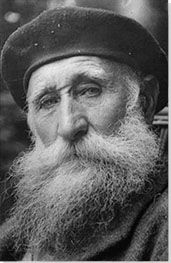Summary of Aristide Maillol
Maillol is best known as a sculptor who specialized in statues of female nudes. His early career saw him excel as a painter and designer of tapestry and he became associated with the decorative Nabis group, where he fell under the influence of his great idol Paul Gauguin. He turned to sculpture in his late thirties (due largely to failing eye-sight) and it was in this medium that he truly stamped his mark on the history of modern art. Maillol avoided the flowing, romantic, sculpture of his famous contemporary, Auguste Rodin, focusing rather on a purer, more restrained, type of sculptural tradition that dated back to Classical Greece and Rome. He drew on the narratives of mythology, and focused his creative energies on sculpting the idealized female figure.
Accomplishments
- Maillol turned to sculpture at a time when all emphasis was being placed on capturing movement. He is, through a return to classical principles, responsible for altering attitudes within modern sculpture. Maillol achieved this impressive feat by approaching the female nude, not as an active subject, nor as an object of desire, but rather from a more analytical position that allowed him to rethink current trends in modernist sculpture.
- Maillol's monumental figures closely followed Classical Grecian sculpture in the way they used the human body to explore relations between mass, volume, line, and contour. The fact that he reintroduced this more studied approach to modern sculpture was considered both audacious and original. By refusing to amplify movements and gestures, he was able to direct all his attention towards producing a simplified naturalism in his figures.
- As one of the Nabi group, Maillol opened up a range of new stylistic possibilities through his emphasis, in works such as The Wave, on the principles of color which he presented through his innovative patchwork technique. One finds in his early paintings his passion for experimentation that would characterize his sculptural works.
- The idea that Maillol produced works with an objective eye distracts from the fact that his sculpture could be allegorical. Indeed, works he produced in the lead up to the Second World War carried a real sense of apprehension. With The River, for instance, his figure contains an aura of terror which the viewer experiences by having to look downwards to meet the terrified gaze of his fallen nude.
- In his final pieces, Maillol produced (for the first time in his view) "works of art". In what appeared to be a response to the horrors of war, the artist focused on the natural beauty of the female form. In Harmony, his final piece, he sculptured Dina Vierny, his preferred model, directly rather than from sketches. As a result, this sculpture became more "alive" than his previous, more analytical, sculptures.
Important Art by Aristide Maillol
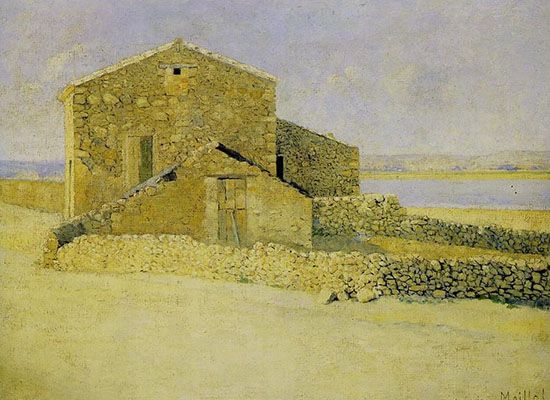
House in Roussillon
Maillol moved to Paris in 1881 (aged 20) and from 1884 he had taken to returning home for the summer months. It was there that he "discovered" natural light, and between 1885 and 1886, he produced several paintings of old stone hillside houses from a high vantage point using impressionistic daubs of varying density and length.
The famous (last) Eighth Impressionist Exhibition of 1886 - which brought together works by Degas, Cassatt, Zandomeneghi, Forain, Gauguin, Monet, Renoir, and Pissarro - coincided with the birth, through Georges Seurat and Paul Signac, of Neo-Impressionism. Neo-Impressionism immediately signalled the onset of Post-Impressionism and Maillol had been captivated by the works which he discovered at the Salon des Independants.
His early paintings of this period experimented with a combination of styles. During his summer jaunts, Maillol painted the facades of the village of Puig-del Mas experimenting with the Post-Impressionist style that borrowed from Van Gogh, Matisse, and Degas. These works had their own poetic quality but it was House in Roussillon that proved to be his first significant work. Maillol had, over two summers, finessed a markedly different approach to the landscape by bringing to the countryside the subtle pastel tones and delicate precision associate with Degas. Indeed, House in Roussillon is as much about the artist's delicate modulation of hues and light as it is about technical accuracy. The art critic Maurice Guillemot so admired this piece that he visited the artist in his studio, and while Guillemot implored Maillol to produce more landscapes in this style, the artist's future was headed in a different direction.
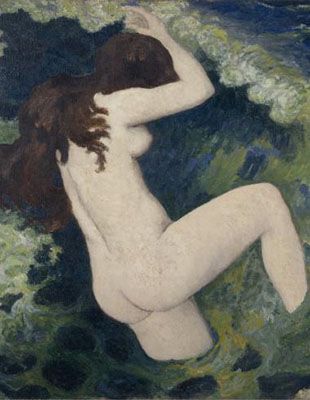
The Wave
A naked woman, with long dark hair and her back facing the viewer, dominates the center of The Wave. Stumbling in blue-green water that reaches to her upper thigh, she seems to be at the mercy of natural forces. Indeed, the crest of a long wave, capped with a line of white foam, is travelling down towards her from the top of the canvas.
This work serves as an important example of the paintings Maillol created early in his career. It embodies the style of the Nabi group; most evident here in the vivid, large patches of color which make up the water and the flat forms of the figures. It is thought the painting was inspired by the group's leader (and Maillol's idol) Paul Gauguin. Maillol's fascination with the water, so much a part of his childhood, is also evident here. Acknowledging this he once wrote, "I do studies of the sea. It feels strange painting the sea, you never know what colour it is".
While Maillol is better known for his female nude sculptures, this painting provides one of his earliest explorations into the subject; which he was only able to do having found a willing model in his wife, Clotilde Narcisse. According to author Bertrand Lorquin, this painting may have been created originally with the intention of being used as a design for the stage; an artistic pursuit Maillol took up briefly during this period.
Oil on canvas - Collection of Musée du Petit Palais, Paris
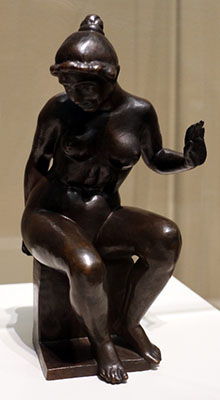
Leda
Typical of Maillol's small-scale sculptures, Leda features is seated nude female. However, her head is bowed; her body turned towards her right; while her left arm is raised with palm outstretched as if attempting to push away (rather than invite the gaze of) the viewer.
A narrative piece, this work, one of his earliest bronze sculptures, is Maillol's interpretation of the Greek myth in which the god Zeus takes the form of a swan in order to seduce the Spartan Queen, Leda. While the subject has been the source of great inspiration for artists, not least the masters of the Renaissance, Maillol's approach is the very embodiment of modernity. While his preliminary sketches and early drafts reveal an attempt to include the swan, in the final work we see that it has been removed. The forward-thinking approach to this work lies in the fact, as explained by author Bertrand Lorquin, that, "the only reference to the violence of the myth is the gesture of her raised hand repelling the god's advances with deep shame. There are in fact no overt allusions at all to the myth, which has been pared down to the delicate pose of a young girl leaning forward slightly to push back the ardor of an invisible god". Even as his sculptures became more ambitious in scale, it was the isolated form of the female figure who will be all that links the viewer to the original source of the myth.
Having been bought by one of his patrons, the French writer Octave Mirbeau, the sculpture made a strong impact on fellow Frenchman Pierre-Auguste Rodin. When the legendary sculptor saw Leda on display in Mirbeau's home, Rodin commented, "Maillol is as great as the greatest sculptors. In that little bronze, you see, he sets an example for everyone, the old master as well as the young neophyte. (...) What's admirable about Maillol, and I'll even say what is eternal about him, is the purity, the luminousness, the transparency of his technique and thought".
Bronze - Collection of Art Institute of Chicago, Chicago
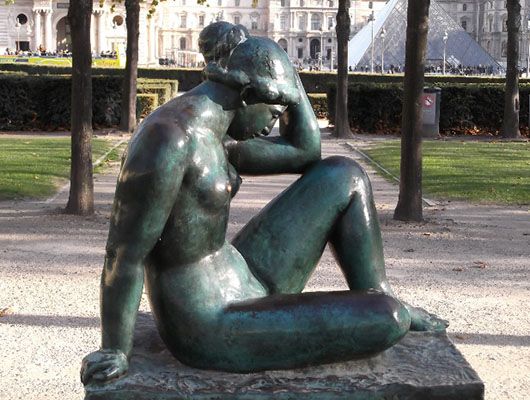
La Méditerranée
Aristide Maillol's large-scale sculpture, La Méditerranée, features a nude female. Highly posed, as was the case with most of his figures, the woman is a masterclass in balanced opposites. Her right arm is extended straight behind her as is her right leg; while her left leg is bent on which rests her left elbow. She looks downward as if in repose as she cradles her head in her left hand. The sculpture is a prime example of how perfectly composed his figures were and as if designed specifically for the space in which they would reside. According to author Bertrand Lorquin, "her body occupies a neat square; the volumes are so perfectly balanced that she could be described as an abstract construction of an idealized woman absorbed in thought".
Rather than strive to capture perfect motion, Maillol looked to the lessons of the Classicists to inform on an abstracted essence of the human figure. Indeed, Lorquin recorded that "though his wife modelled for it, he did not want the finished sculpture to contain any element of resemblance or imitation of reality [...] Maillol wanted something more vigorous and structured".
Maillol's interest in minimizing the empty space surrounding the figure is evident here in the tightness of the composition. The concept of space is deliberately limited in this figure, and as Lorquin explains, Maillol "felt he had to knit together the different parts of the body, to make each one of them fully meaningful within the cubic volume determining the composition". For his part, the artist alluded to the relationship between this work and architecture: "the reason I strive to bring the limbs together is that one enters a sculpture as one enters a house" he stated. As one of the pioneers of contemporary sculpture, Maillol's analytical approach would resonate in the more abstract approach of future generations of sculptors including Constantin Brancusi and Henry Moore.
Bronze - Collection of Louvre Museum, Paris
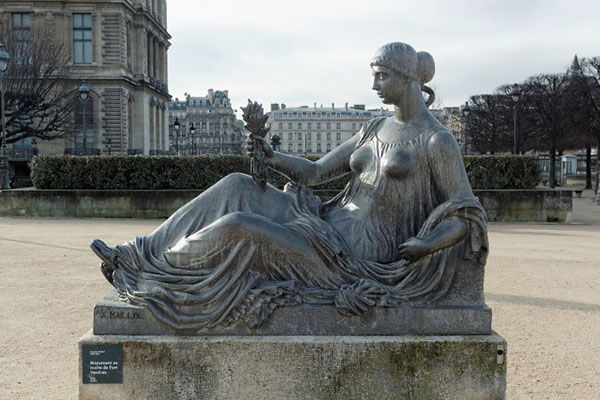
Port-Vendres Monument to the War Dead
A larger-than-life-sized female is the subject of Maillol's sculpture Port-Vendres Monument to the War Dead. Depicted in a reclining position, wearing a dress with multiple folds, her legs are outstretched with her left arm, on which she cradles a shawl, bent back to support the upper half of her body. Looking out with a contemplative expression, in her right hands she holds a cluster of olive branches. The figure closely resembles, in fact, Maillol's earlier (1912) commission for the Aix-en-Provence (though refused on completion and subsequently housed at Musée d'Orsay) dedicated to the memory of the French master Paul Cézanne.
Maillol was commissioned in 1919 to make the work by the local government to honor the young men who had been killed in action during the First World War. While many artists at the time received such commissions, Maillol's approach to the subject was unique. Unlike the more typical scenes of battle, fallen soldiers, or depictions of overwhelming grief and anguish, Maillol chose what author Bertrand Lorquin describes as, "a silent image to express the tragedy of a nation's youth being sacrificed in battle". A revolutionary approach to such a monument, Maillol described his reasoning, as "one can express grief with motionless features but not with a twisted expression and wide open mouth". Rather than focus on anguish, the olive branches the woman holds makes a statement about the hope for peace; while her look of pensive reflection asserts the quiet dignity and strength of the French people in their time of great loss. In 1994 the sculpture was classified as a historic monument and a bronze copy was made and located in in the Jardin des Tuileries in Paris.
Lead - Collection of Louvre Museum, Paris (Jardins du Carrousel)
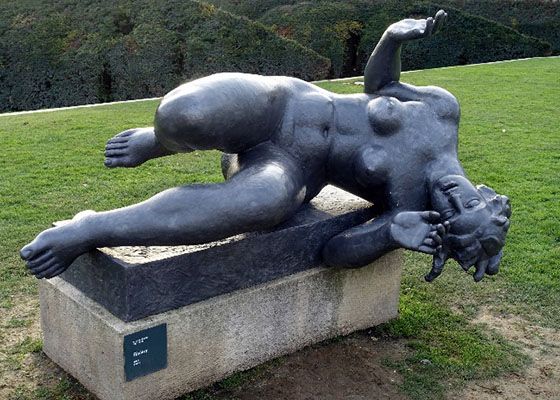
La Rivière (The River)
Maillol's most audacious sculpture went against the grain of his still, formally balanced nudes. In particular, La Rivière defied all conventions for "upright" monuments by having his figure placed, haphazardly and seemingly falling, below the line of her pedestal. In so doing, Maillol's most famous sculpture introduced a new relationship between viewer and sculpture since his prone figure asks the viewer to look downward (rather than upward) in order the meet her agonized gaze.
La Rivière stemmed from a commission to honor the French writer and pacifist Henri Barbusse. Conceived of initially as a work on the theme of war, the monument was intended to represent a woman who had been stabbed in the back and was falling, possibly to her death. The commission fell through, however, and Maillol transformed his original idea into La Rivière. When one takes into consideration the title of the sculpture, one can find clear thematic links with his early painting, The Wave, which also presents a young woman at the mercy of currents of natural water that threaten to overwhelm her.
While this sculpture, too, features a female nude, it was in the words of the author, and son of Dina Vierny, Bertrand Lorquin (effectively speaking about his mother here), "one of the most tension-filled and tormented of Maillol's works". As he explained, the figure "appears to be swept by a momentum that no human power can contain [while the] head expresses a kind of terror and the hands seem to be trying to arrest the current that is sweeping it along". That this work was created as the world was in a state of anxiety over the march of fascism, it is hard to imagine that Maillol (who had lived through the First World War) would not be feeling that anxiety and might then turn to his art as a vehicle for channeling these fears.
Lead - Collection of Louvre Museum, Paris (Jardins du Carrousel)
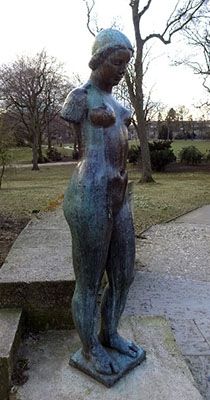
Harmony
Harmony features a sculpture of a young woman. Missing her arms, she stands in a contrapposto style with her left hip raised; her right knee slightly bent. Her hair is pulled back with two braids into a knot allowing focus on her facial expression as she looks innocently downward.
An important sculpture, it was the unfinished piece Maillol was working on at the time of his death, and during the years ravaged by the horrors of the Second World War. In many ways this work is a culmination of a career-long obsession with the female form. Beginning with the standing figures of early works such as Pomona in 1910, we see here a maturation of his female form. It is no surprise that the arms are what were left unfinished since his figures always began with the perfection of the torso. According to author Lorquin, "Maillol always began modelling the torso, and only once he was satisfied with it did he add limbs. Adding limbs was always his greatest worry, especially when sculpting standing figures". Even when describing the famed Ancient Greek sculpture Venus de Milo (101 BC), Maillol found the lack of her arms of no consequence, stating that their presence, "would add nothing to its beauty. On the contrary they would probably detract from it".
As the title (Harmony) reflects, it could be assumed that in this work Maillol was searching for a feeling of equilibrium for his beloved nation. To think however that this was all this sculpture was for Maillol would be incorrect; rather he was trying to move his sculpture forward in a new direction. Once more he turned to his model and muse Dina Vierny as inspiration but in this work he was much less interested in balanced forms. Usually only working off drawings of his models, Maillol described what he wanted to achieve thus: "I want this work to be more realist and alive than anything I have done up until now. That is why I am for once working directly from a model, and not just from drawings, as I usually do [...] It is a form and a preconceived idea that guides the artist. Followed by gracefulness, power, and all other qualities which accrue in the course of the work, and as a result the work is not just the realization of an idea, of an intellectual conception, but it is also a work of art". Harmony may have been unfinished, but it stood as the most fitting epitaph for an artist who sits on the very highest plateau of modern sculpture.
Bronze - Collection of Hofgarten Park, Düsseldorf, Germany
Biography of Aristide Maillol
Childhood and Education
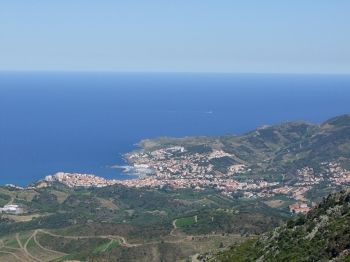
Aristide Maillol was the second youngest of five children born to Raphaël Maillol and Catherine Rougé. Since his father, a draper, was often travelling for work and his mother showed little interest in his day-to-day upbringing, he was raised by his aunt Lucy and his paternal grandfather who worked as a fisherman. Even at an early age, Maillol loved the landscape and surroundings of the Mediterranean Sea town of Banyuls-sur-Mer where he grew up. Returning there often to live and work throughout his life, he once stated: "my village, which I love more than anything I have ever seen, has every resource to offer a painter - it's as if a golden dust had been scattered over the entire area".
Maillol's childhood was a sad one and he suffered many losses (beginning at the age of ten when his older brother, Adolphe, died) which affected his temperament. Indeed, according to the account of the artist's muse and model (and, following his death, nominated executor of Maillol's estate) Dina Vierny, he was, "temperamentally different from the other children of his own age, [and so] he grew up a solitary child". In 1874 he was enrolled in a boarding school in a nearby town and was so lonely that his aunt was compelled to visit him once a week in an attempt to rally his spirits. It was at the school, however, that he was able to take art lessons and where he created his first proper painting at the age of thirteen; a landscape of Banyuls.
Personal setbacks continued into Maillol's teenage years beginning with the death of his father in 1877. His father's passing greatly reduced the family's already modest income and they were forced to live off produce from their vineyards which were then tragically destroyed by a phylloxera epidemic three years later. Despite these setbacks, Maillol left boarding school in 1879 to return home where he resolved to become a professional artist. Two years later he enrolled in art classes at the nearby Musée Hyacinthe Rigaud.
Early Training
Having fully committed to becoming an artist, Maillol, with the somewhat hesitant support of his aunt Lucy, decided he needed to study in Paris. He left for the French capital in 1881 with her pledge of a meager twenty francs a month allowance. Upon arrival, he took the entrance exam for the École des Beaux-Arts but failed (several times in fact) and so signed up to audit one of the classes being taught by Jean-Léon Gérôme. Two years later (in 1883) he enrolled in the École des Arts Décortifs but his financial situation was so dire his health began to suffer and he was repeatedly hospitalized. Of this time, Maillol would later write: "How did I manage? I was very ill and nearly died. Ill-nourished and rheumaticky and neglected, my resistance to disease was low and I spent long periods in hospital. When I came out I simple relapsed into poverty. Sometimes I thought I would jump into the Seine and finish it". His perseverance paid off however and in 1885 Maillol was finally accepted into the École des Beaux-Arts. It did not take long, however, before he grew dissatisfied with his training.
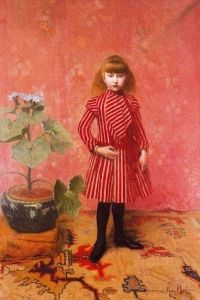
Despite his dissatisfaction with his formal education, Maillol made good connections during this early period leading to a shared dwelling with young artist Antoine Bourdelle. According to Dina Vierny, Maillol survived, "on cheese and milk in indescribable poverty with never even a few centimes for a beer". He was able to derive a limited income source after meeting Maurice Boucher who hired him to create stage sets for his theater. More importantly, he was exposed to his first exhibition of Impressionist and Synthetic paintings. The exhibition featured Paul Gauguin who would have a profound impact on the artist's future work. He said later, "Gauguin's painting was a revelation to me. Instead of enlightening me, the École des Beaux-Arts had thrown a veil over my eyes. Standing in front of the Pont-Aven paintings, I had a feeling that I too could work in that spirit. Right then I told myself that what I did would be good when it had Gauguin's approval".
Mature Period
Maillol's career began in effect in Paris and his time there laid the foundations for his future work. It was in Paris that he began exhibiting in salons in the late 1880s from where he received his first commissions. It was at this time that he also met artist József Rippl-Rónai which led to his role in the Les Nabis of painters. His early portraits would contain the large flat swaths of color and simply formed shapes characteristic of this art movement. In addition to Rippl-Rónai, he developed lifelong friendships with others in this group including his idol Gauguin, Maurice Denis, and Édouard Vuillard.
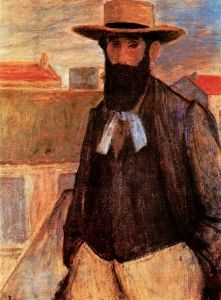
In 1892, Maillol became interested in tapestry and took lessons at Paris's Cluny Museum. After a short period of study, he exhibited his first work in this medium in 1893 and set up a tapestry studio in his hometown of Banyuls-sur-Mer where he hired two assistants, Angélique and Clotilde Narcisse. Having fallen in love with Clotilde, the two returned to Paris. They would marry in July of 1896 and their only child, a son, Lucien, would be born in October of that year. Clotilde had a profound impact on the direction of Maillol's art. He now had a wife and a willing model, and for the first time, nudes began to appear in his work.
Once back in Paris, Maillol began to create his first sculptures, initially carved from wood. It was his tapestries however that were receiving most attention. This was due in part to Gauguin, who in a published review of one of his exhibitions, wrote, "Maillol is showing a tapestry which is beyond praise". Another fan was Romanian princess Elizabeth Bibesco who commissioned a tapestry in 1897. Maillol was now able to set up his own house and studio in the Villeneuve Saint-Georges section of Paris and this became a gathering place for the Nabi group and others including Henri Matisse (who became a lifelong friend) and Pablo Picasso.
Unfortunately, the intense close-up work associated with tapestry caused great strain on Maillol's eyes, and fearing permanent loss of his sight, he chose to change focus. With regret, he turned his attention almost entirely to sculpting. Creating impressive work from the start, Maillol quickly transitioned from wood to bronze. He immediately took to the material, and in 1900 made thirty small statuettes. He also began working on the large-scale sculptures for which he would become better known. He had his first one-man exhibition in 1902 through friend and art dealer Ambroise Vollard. The exhibition was well received and with his new-found success, Maillol was able to move to Marly-le-Roi where he established a studio and built a house. He would spend the rest of his life dividing time between this home in the summer and his hometown of Banyuls in the winter.
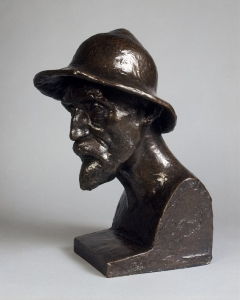
Maillol's career was nurtured by the connections he made with fellow artists and patrons. For instance, his friends were responsible for securing several memorial commissions for Maillol. These relationships were reciprocal, however, and Maillol influenced those he associated with too. Most notably, he was responsible for a large aspect of Pierre-Auguste Renoir's oeuvre when in 1907, while watching Maillol sculpt his bust, Renoir was inspired to try his hand at sculpture.
It was Rodin who introduced Maillol's to the German Count Harry Kessler in 1905. The Count would become a loyal patron, responsible for key commissions including Maillol's La Méditerranée (1905). In 1908 the two men travelled to Greece where Maillol was influenced by ancient monuments and sculptures including those at the Parthenon and Propylea. In addition, Kessler founded his own printing press, and frequently commissioned Maillol to create drawings for his publications. Maillol's frustration with the paper he was working with led him to design and produce his own. In 1913, with backing by Kessler once more, Maillol opened his own shop to produce the paper under the supervision of the artist's nephew. Titled "Montval" the paper still exists today.
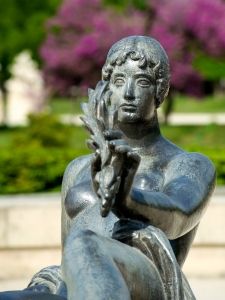
Kessler was responsible, albeit unintentionally, for some damage to Maillol's reputation. In 1914, on the precipice of the outbreak of the First World War, Kessler sent a cable to Maillol instructing him to bury his statues so that they would not suffer any damage. This letter led to French officials investigating Maillol for treason although the charges were ultimately dropped. In addition, two articles were published that questioned Maillol's loyalties and his close connections to his German patron. This coupled with his son being conscripted into battle caused Maillol to sink into depression and he would not create any new work for the duration of the war. At the war's end, and on his son's safe return, Maillol started to emerge from his depression. Creating again with a renewed energy, he received numerous commissions including monuments to honor France's fallen soldiers in the towns of Banyuls-sur-Mer and Port-Vendres as well as a statue dedicated to the honor of the French master, Paul Cézanne.

With increased success and attention abroad, including a one-man exhibition in Buffalo in 1925, Maillol turned to travel once again. In 1929, he journeyed to London and Germany where he had the opportunity to meet Albert Einstein. A year later he returned to Germany with Kessler where he was introduced to numerous gallery and museum professionals and in 1936 he travelled to Italy where he was overwhelmed by the works of Raphael and Michelangelo.
Later Period
Maillol's art was deeply impacted in 1937 when he received a letter from a friend telling him of a young woman, Dina Vierny, who strongly resembled his ideal figural type. Excited at meeting such a person, Maillol wrote to Vierny: "Mademoiselle, I am told that you look like a Maillol or a Renoir. I'd settle for a Renoir". Intrigued, Vierny agreed to travel to meet with the artist and the two began a working relationship with her serving as Maillol's sole model for the rest of his life. She even moved into a house near the artist, despite his wife's displeasure at the arrangement. With a renewed sense of direction came a renewed sense of energy for life and, according to author Bertrand Lorquin, "toward the end of his life he would go on long tramps in the mountains, where his gaunt erect figure would become a familiar sight", observing that the artist "always wore a long light-brown or beige jacket with a cap or soft hat in matching tones". Later still he would favor a beret that coupled his most remarkable feature, a long gray beard.
As in the early years of Maillol's life, his last decades were filled with loss and unhappiness. He saw the death of many friends including Kessler in 1937. The outbreak of the Second World War also had a profound impact on him. He was, in effect, trapped in Banyuls, but he continued to work and according to Vierny he was working an average of ten hours each day. Once more, a mistake in judgement led to rumors that negatively impacted Maillol's reputation. German officers often wanted to visit his work and Maillol had no choice but to let them into his home. Then in 1942, he was invited to the opening of an exhibition in Paris of an artist, Arno Brekker, who was one of the Nazi sanctioned sculptors. According to Lorquin, Maillol, "made the mistake of accepting, mainly because it gave him an opportunity to cross over into the occupied zone and visit his studio at Marly-le-Roi to check on the state of the sculptures he had been obliged to abandon there. He was totally unaware of the political significance of this act, which was bitterly held against him. Later, he was wrongly accused of having collaborated with the Germans".
The fact of the matter was that Maillol played a key role in helping to stop the spread of Nazism. Hard at work in his studio in Banyuls, according to Lorquin, Vierny, "informed him of her activities in the Resistance and her efforts to help people wanted by the Germans to flee France [Maillol] immediately offered to let her use his studio in the village of Puig del Las as a refuge. He also showed her safe passage over the Pyrenees, and in fact the first clandestine network to spirit people across the border into Spain was called "le réseau Maillol" (the Maillol network).
On September 15, 1944 while travelling to visit artist Raoul Dufy, Maillol was in an automobile accident. He died twelve days later due to complications from his injuries. Amongst his unfinished works was a figure called Harmony; a sculpture that was destined to become one of his signature works.
The Legacy of Aristide Maillol
Aristide Maillol helped alter fixed ideas about modern sculpture. Looking back in history to the idealized forms of classical sculpture, he created modern works that were not committed to capturing impressions of motion. Rather than striving to render the "living" figure, Maillol created what author Bertrand Lorquin called "pure sculpture based on the body's architecture and on a harmony between volumes".
His drive towards more idealized, simplified, forms provided the foundation for the next generation of sculptors. For Lorquin, indeed, Maillol had "rediscovered simplicity and was, with the Cubists, one of the pioneers of abstraction and modernism in sculpture". His influence can be traced in the sculptures of Jean Arp, Constantin Brancusi, and Henry Moore. The argument could be made with some conviction that Maillol pre-empted the purer abstract forms preferred by contemporary artists such as Anish Kapoor, Joan Miró, Isamu Noguchi, and Franz West.
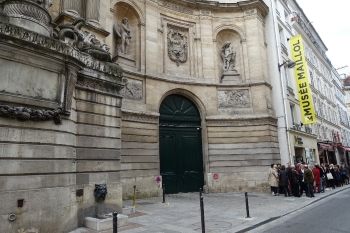
Shortly after the end of the Second World War, Vierny set up her own art gallery. As well as maintaining a fine collection by Western and dissident Soviet artists, she continued Maillol's legacy by establishing the Dina Vierny Foundation, leading eventually to the creation in 1995 of the Foundation Dina Vierny-Musée Maillol in the left-bank rue de Grenelle. Maillol's former home in the family vineyard above Banyuls also houses a Maillol museum.
Influences and Connections

![André Gide]() André Gide
André Gide![Octave Mirbeau]() Octave Mirbeau
Octave Mirbeau- Count Harry Kessler
- Ivan Morosov
- Dina Vierny
-
![Art Nouveau]() Art Nouveau
Art Nouveau -
![Impressionism]() Impressionism
Impressionism -
![Les Nabis]() Les Nabis
Les Nabis - Ancient Egyptian Art
- Archaic Sculpture
![André Gide]() André Gide
André Gide![Octave Mirbeau]() Octave Mirbeau
Octave Mirbeau- Count Harry Kessler
- Ivan Morosov
- Dina Vierny
